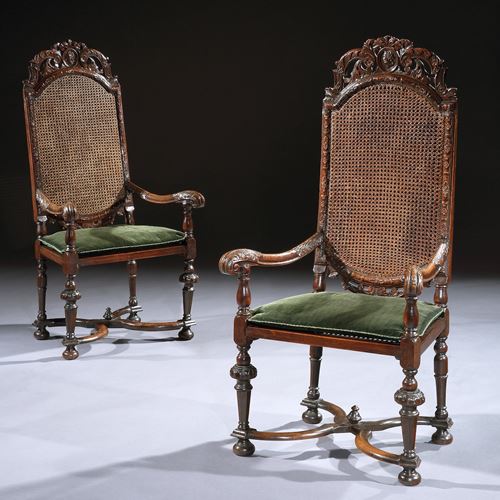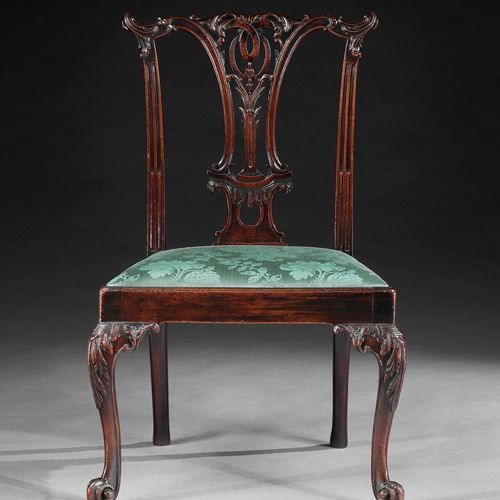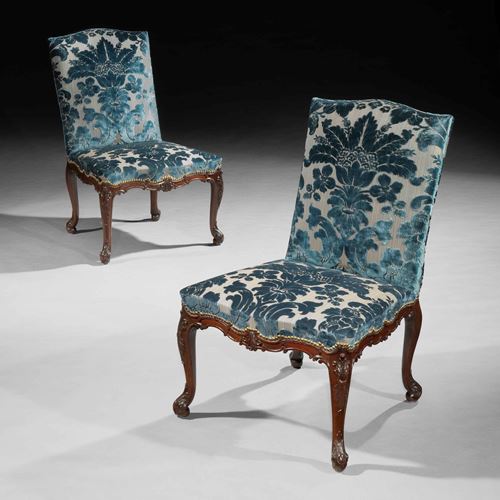search
1/10
THE BRAMSHILL PARK ARMCHAIRS
england , circa 1770
A HIGHLY IMPORTANT PAIR OF GEORGE III GILTWOOD ARMCHAIRS
ATTRIBUTED TO INCE AND MAYHEW, CIRCA 1770
Each with shaped oval backrest centered by a lion's mask, the drapery-form armrests with lion's-head terminals on foliate-carved supports flanking a damask upholstered seat, the front seat rail centered by satyr's masks, raised on square tapering legs with trailing husks, spade feet, with variations to the carving particularly to the lion's-head armrest terminals, each inscribed in black ink 8366 / Winchester to interior of seat rails.
ATTRIBUTED TO INCE AND MAYHEW, CIRCA 1770
Each with shaped oval backrest centered by a lion's mask, the drapery-form armrests with lion's-head terminals on foliate-carved supports flanking a damask upholstered seat, the front seat rail centered by satyr's masks, raised on square tapering legs with trailing husks, spade feet, with variations to the carving particularly to the lion's-head armrest terminals, each inscribed in black ink 8366 / Winchester to interior of seat rails.
Provenance
Part of a suite presumably commissioned by Sir John Mordaunt Cope, 8th Bart. (d.1779) or his cousin and heir the Rev. Sir Richard Cope (1719-1806) for Bramshill Park, Hampshire - the suite photographed in situ
Thence by descent to Sir Anthony Cope, Bt., Eversley Manor, Hampshire
A set of six sold by Sir Anthony M.L. Cope, Bt., formerly of Bramshill; Sotheby's, London, 27 April 1956, lot 99.
The Collection of Lord Astor, Cliveden, Berkshire.
Acquired from Partridge, London (1981)
Private Collection, USA
Thence by descent to Sir Anthony Cope, Bt., Eversley Manor, Hampshire
A set of six sold by Sir Anthony M.L. Cope, Bt., formerly of Bramshill; Sotheby's, London, 27 April 1956, lot 99.
The Collection of Lord Astor, Cliveden, Berkshire.
Acquired from Partridge, London (1981)
Private Collection, USA
Stock number
S10.65
dimensions
More Details
Literature
Height: 40 in (101.5 cm)
Width: 26¹/₂ in (67.3 cm)
Depth: 27¹/₂ in (70 cm)
Width: 26¹/₂ in (67.3 cm)
Depth: 27¹/₂ in (70 cm)
This exceptional pair of giltwood armchairs is part of a large suite of seat-furniture, comprising at least twelve chairs, formerly at Bramshill Park, Hampshire, seat of the Cope family (illustrated, ‘Bramshill Park, Hampshire: The Seat of Sir Anthony Cope, Bart.’, Country Life, 11 July 1903, p. 56, ‘The State Drawing Room’; and 23 June 1923, p. 886, figs. 1, 2). The set was probably commissioned by Sir John Mordaunt Cope, 8th Bt. (1731-79) for his London residence, or for Bramshill.
From this set, three of the chairs were acquired by the great collector Sir William Lever, 1st Viscount Leverhulme (1851-1925) from the dealer, D.L. Isaacs, before 14 September 1905, for about £100, and are now in the Lady Lever Art Gallery, Port Sunlight (L. Wood, The Upholstered Furniture in the Lady Lever Art Gallery, New Haven and London, 2008, vol. II, pp. 617-626). A single chair but with replaced cabriole legs was with the dealer Jacques Seligmann, then gifted by Archer M. Huntington to the Metropolitan Museum of Art, New York, in 1936 (36.19). These four chairs may have been part of a group of six as indicated by the pencil numbers on the frames of the Lever chairs, and disposed of following the death of the Rev. Sir William Henry Cope, 12th Bt., in 1892. Six further chairs were sold by Sir Anthony M.L. Cope, Bt. from Bramshill, Sotheby's, London, 27 April 1956, lot 99.
The latter six chairs were later in the Astor collection at Cliveden; two chairs remain in the possession of Lord Astor (photographed by Country Life, 6 October 2005, p. 94) and were previously photographed on loan in the Boudoir at Berrington Hall, Leominster (NTPL 50470). A further two are the present pair of chairs, and the final two from this group were probably those recently sold by us in 2021. At least one of the our chairs bears the same inscription to the back seat rail as the present lot, Winchester, and also has cramp cuts to the back rail, as does one chair from this pair.
There are at least seven sofas of this design but with slight variations suggesting they are from the same workshop but not the same suite. These include: one sold Christie’s, London, 27 November 2003, lot 59; another at Mapledurham House, Oxfordshire; a pair of sofas with Mallett at Bourdon House in 1993 (advertised Country Life, 24 June 1993, p. 45); a sofa with Needham's in 1965, and two in a private collection in 1974 (Wood, 2008, ibid., figs. 390-392). A sofa of the Mallett/Needham model is depicted in a painting, The Sofa, by R.T. Lonsdale (fl. 1826-46), exhibited at the Royal Academy in 1846 (catalogue no. 72; Wood, ibid., fig. 393). Another sofa reduced in length was sold Christie’s, London, 12 April 2018, lot 262.
SIR WILLIAM CHAMBERS AND INCE AND MAYHEW
The lion-pelt motif has led to speculation that these chairs may have been designed by Sir William Chambers (1723-96), based on the decoration of a Chambers chimneypiece (Avery Library, Columbia, reproduced in J. Harris, Sir William Chambers, Knight of the Polar Star, London, 1970, fig. 185). The chairs are attributed to the Golden Square firm of John Ince and William Mayhew, one of the leading cabinet-making firms of the period and perhaps the most accomplished rivals to Chippendale. There is a connection between Chambers and Ince and Mayhew; Chambers subcontracted work to craftsmen, and acted as paymaster on projects he was involved in (see: H. Roberts and C. Cator, Industry and Ingenuity: The Partnership of William Ince and John Mayhew, London, 2022, p. 149). The bank customer ledgers for Chambers at Drummonds Bank show he was regularly employing the same craftsmen including Ince and Mayhew: in 1766, to ‘Ince & Co.’; in 1771, ‘Receipt Mayhew on Croft & Co 300’ (Wood, ibid., pp. 175-176). Certainly, Mayhew was engaged in the period during Chambers’s extensive commission for the 4th Duke of Marlborough at Blenheim Palace beginning in late 1769 (ibid., p. 199).
The distinctive arched back, with hollowed base-rail, corresponds to a form adopted by Ince and Mayhew; see the suite supplied in the 1780s for Chirk Castle, Wrexham (C. Hussey, 'Chirk Castle, Denbighshire, IV', Country Life, 12 October 1951, p. 1149, fig. 4 and G. Beard & C. Gilbert (eds.), The Dictionary of English Furniture Makers, Leeds, 1986, p. 596). In addition these chairs exhibit the characteristic Ince and Mayhew paneled leg that relates very closely to those found on chairs supplied to the Earl of Darnley at Cobham Hall, Kent, one of the firm's most enduring clients (C. Cator, 'The Earl of Kerry and Mayhew and Ince: The Idlest Ostentation', Furniture History, 1990, pp. 27-29; H. Roberts and C Cator, ibid., p. 362, fig. 319). In addition, Ince and Mayhew notably incorporated idiosyncratic zoomorphic motifs to enhance their furniture – see the ram’s head masks on a pair of urns supplied by the partnership for Lord Kerry’s Dining Room at Portman Square, now in the Lady Lever Art Gallery, Port Sunlight (ibid., figs. 3, 4); the carved giltwood dolphins, originally part of the cresting of one of the pier glasses in the Oval Drawing Room, part of the partnership's 1785 commission for James Alexander, 1st Earl of Caledon (H. Roberts, ‘Unequall’d Elegance…’, Furniture History, 2009, fig. 8); and on a pair of marquetry tripod stands, with ivory ram’s head capitals, attributed to Ince and Mayhew, sold Christie’s, London, 5 July 2012, lot 32.
From this set, three of the chairs were acquired by the great collector Sir William Lever, 1st Viscount Leverhulme (1851-1925) from the dealer, D.L. Isaacs, before 14 September 1905, for about £100, and are now in the Lady Lever Art Gallery, Port Sunlight (L. Wood, The Upholstered Furniture in the Lady Lever Art Gallery, New Haven and London, 2008, vol. II, pp. 617-626). A single chair but with replaced cabriole legs was with the dealer Jacques Seligmann, then gifted by Archer M. Huntington to the Metropolitan Museum of Art, New York, in 1936 (36.19). These four chairs may have been part of a group of six as indicated by the pencil numbers on the frames of the Lever chairs, and disposed of following the death of the Rev. Sir William Henry Cope, 12th Bt., in 1892. Six further chairs were sold by Sir Anthony M.L. Cope, Bt. from Bramshill, Sotheby's, London, 27 April 1956, lot 99.
The latter six chairs were later in the Astor collection at Cliveden; two chairs remain in the possession of Lord Astor (photographed by Country Life, 6 October 2005, p. 94) and were previously photographed on loan in the Boudoir at Berrington Hall, Leominster (NTPL 50470). A further two are the present pair of chairs, and the final two from this group were probably those recently sold by us in 2021. At least one of the our chairs bears the same inscription to the back seat rail as the present lot, Winchester, and also has cramp cuts to the back rail, as does one chair from this pair.
There are at least seven sofas of this design but with slight variations suggesting they are from the same workshop but not the same suite. These include: one sold Christie’s, London, 27 November 2003, lot 59; another at Mapledurham House, Oxfordshire; a pair of sofas with Mallett at Bourdon House in 1993 (advertised Country Life, 24 June 1993, p. 45); a sofa with Needham's in 1965, and two in a private collection in 1974 (Wood, 2008, ibid., figs. 390-392). A sofa of the Mallett/Needham model is depicted in a painting, The Sofa, by R.T. Lonsdale (fl. 1826-46), exhibited at the Royal Academy in 1846 (catalogue no. 72; Wood, ibid., fig. 393). Another sofa reduced in length was sold Christie’s, London, 12 April 2018, lot 262.
SIR WILLIAM CHAMBERS AND INCE AND MAYHEW
The lion-pelt motif has led to speculation that these chairs may have been designed by Sir William Chambers (1723-96), based on the decoration of a Chambers chimneypiece (Avery Library, Columbia, reproduced in J. Harris, Sir William Chambers, Knight of the Polar Star, London, 1970, fig. 185). The chairs are attributed to the Golden Square firm of John Ince and William Mayhew, one of the leading cabinet-making firms of the period and perhaps the most accomplished rivals to Chippendale. There is a connection between Chambers and Ince and Mayhew; Chambers subcontracted work to craftsmen, and acted as paymaster on projects he was involved in (see: H. Roberts and C. Cator, Industry and Ingenuity: The Partnership of William Ince and John Mayhew, London, 2022, p. 149). The bank customer ledgers for Chambers at Drummonds Bank show he was regularly employing the same craftsmen including Ince and Mayhew: in 1766, to ‘Ince & Co.’; in 1771, ‘Receipt Mayhew on Croft & Co 300’ (Wood, ibid., pp. 175-176). Certainly, Mayhew was engaged in the period during Chambers’s extensive commission for the 4th Duke of Marlborough at Blenheim Palace beginning in late 1769 (ibid., p. 199).
The distinctive arched back, with hollowed base-rail, corresponds to a form adopted by Ince and Mayhew; see the suite supplied in the 1780s for Chirk Castle, Wrexham (C. Hussey, 'Chirk Castle, Denbighshire, IV', Country Life, 12 October 1951, p. 1149, fig. 4 and G. Beard & C. Gilbert (eds.), The Dictionary of English Furniture Makers, Leeds, 1986, p. 596). In addition these chairs exhibit the characteristic Ince and Mayhew paneled leg that relates very closely to those found on chairs supplied to the Earl of Darnley at Cobham Hall, Kent, one of the firm's most enduring clients (C. Cator, 'The Earl of Kerry and Mayhew and Ince: The Idlest Ostentation', Furniture History, 1990, pp. 27-29; H. Roberts and C Cator, ibid., p. 362, fig. 319). In addition, Ince and Mayhew notably incorporated idiosyncratic zoomorphic motifs to enhance their furniture – see the ram’s head masks on a pair of urns supplied by the partnership for Lord Kerry’s Dining Room at Portman Square, now in the Lady Lever Art Gallery, Port Sunlight (ibid., figs. 3, 4); the carved giltwood dolphins, originally part of the cresting of one of the pier glasses in the Oval Drawing Room, part of the partnership's 1785 commission for James Alexander, 1st Earl of Caledon (H. Roberts, ‘Unequall’d Elegance…’, Furniture History, 2009, fig. 8); and on a pair of marquetry tripod stands, with ivory ram’s head capitals, attributed to Ince and Mayhew, sold Christie’s, London, 5 July 2012, lot 32.
‘Bramshill Park, Hampshire: The Seat of Sir Anthony Cope, Bt.’, Country Life, 11 July 1903, p. 56, ‘The State Drawing Room’; and 23 June 1923, p. 886, figs. 1, 2.
H. Avray Tipping, English Homes: Period III Vol. II Late Tudor and Early Stuart 1558-1649, Country Life, London, 1927, p. 303, 'The Drawing Room' fig. 383.
Country Life, Eversley Manor, Hampshire - I, 19 March 1943, p 528 - 519, pl. 3 (illustrated)
L. Wood, The Upholstered Furniture in the Lady Lever Art Gallery, Liverpool, 2008, vol. II, pp. 617-629 (a similar example).
H. Avray Tipping, English Homes: Period III Vol. II Late Tudor and Early Stuart 1558-1649, Country Life, London, 1927, p. 303, 'The Drawing Room' fig. 383.
Country Life, Eversley Manor, Hampshire - I, 19 March 1943, p 528 - 519, pl. 3 (illustrated)
L. Wood, The Upholstered Furniture in the Lady Lever Art Gallery, Liverpool, 2008, vol. II, pp. 617-629 (a similar example).

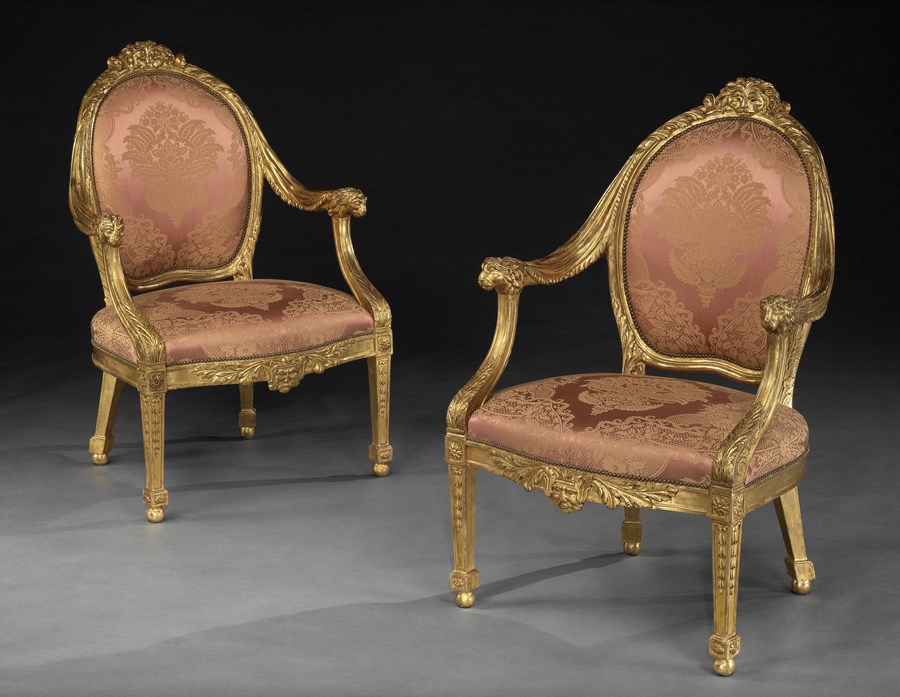

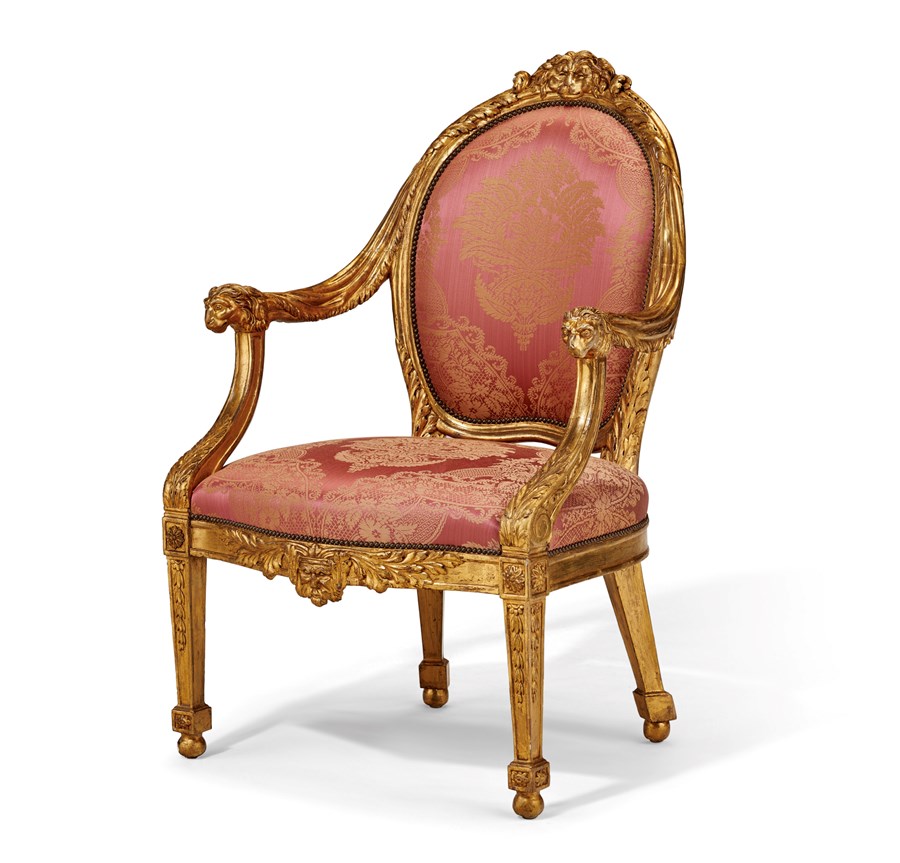
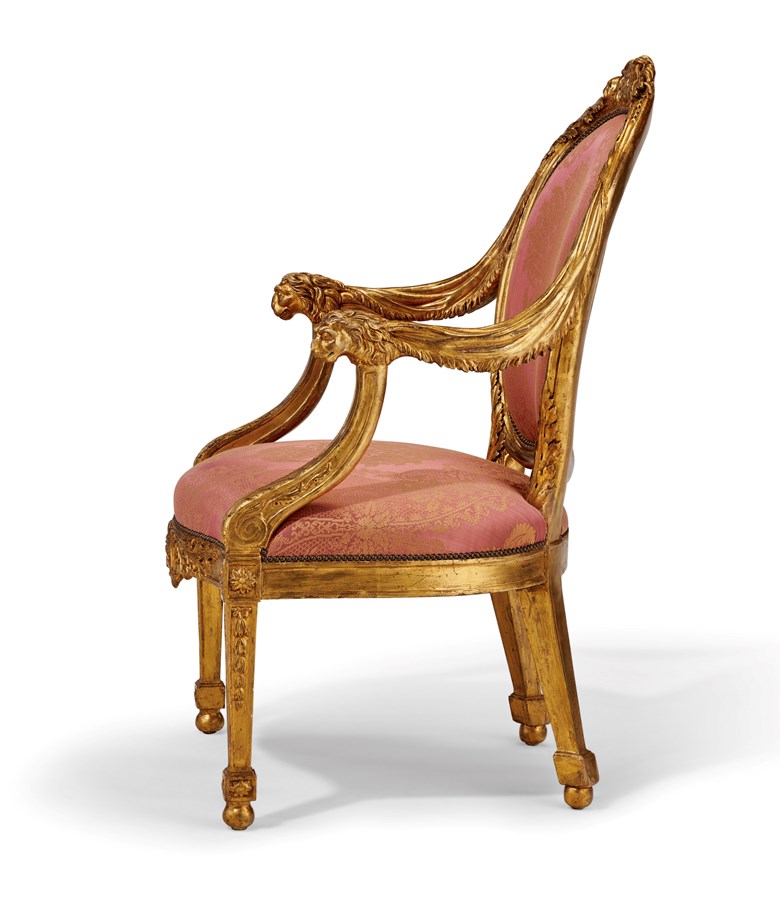
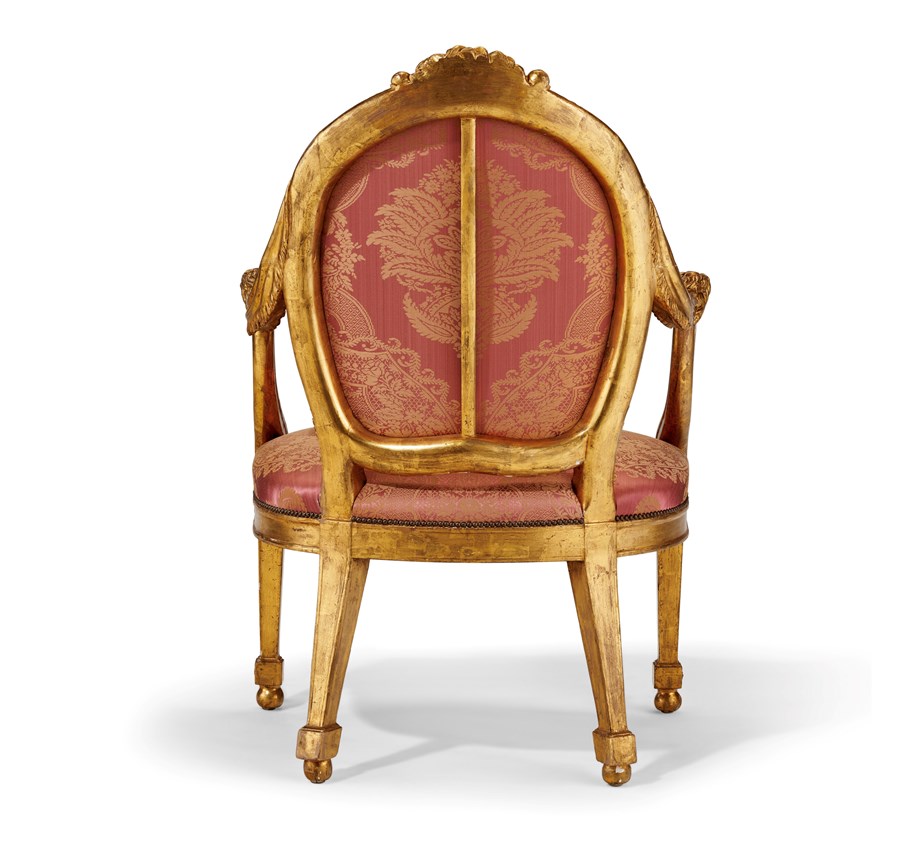
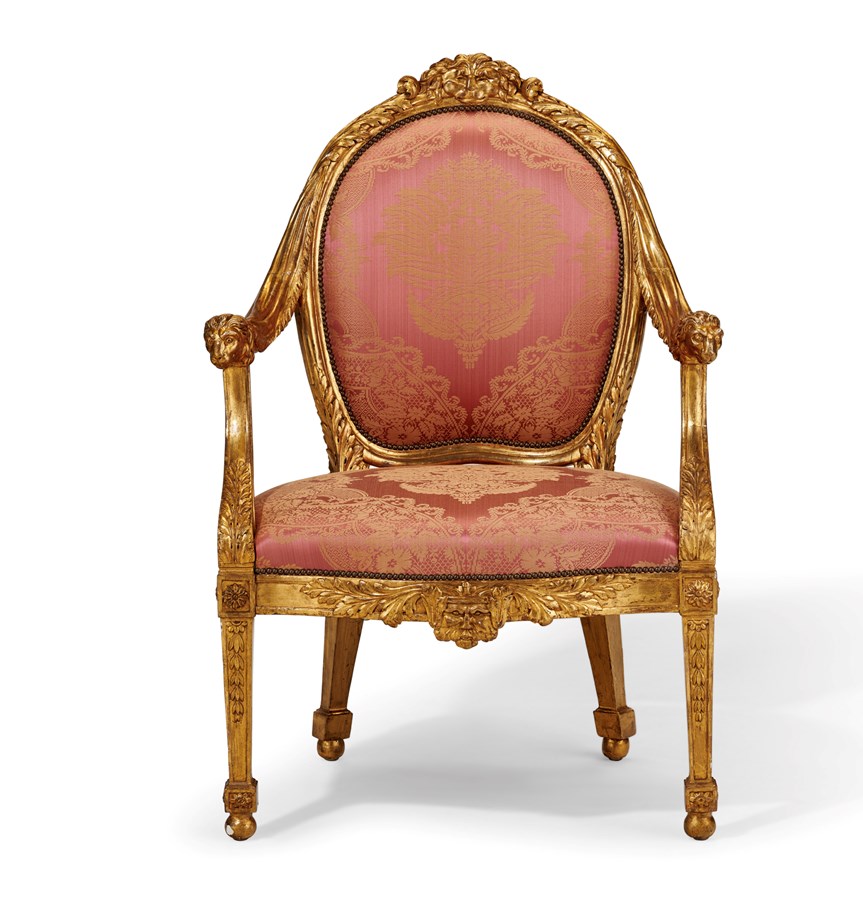
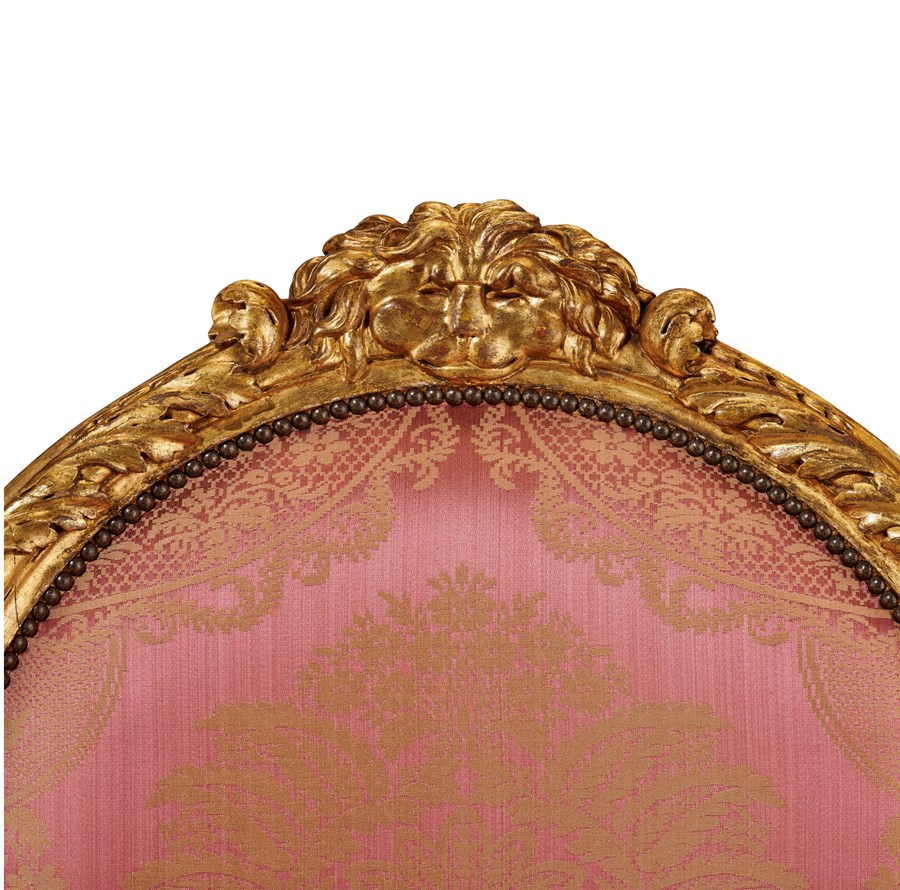
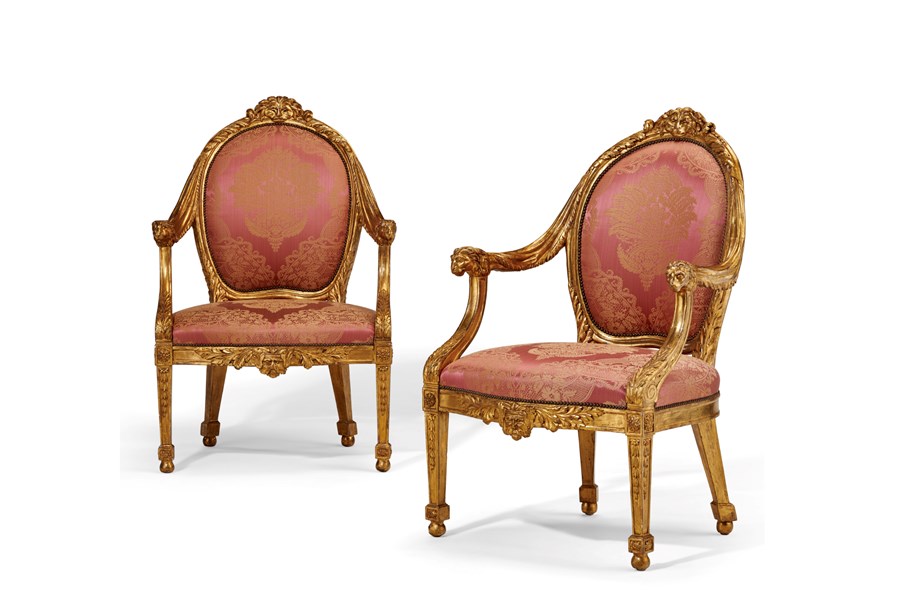
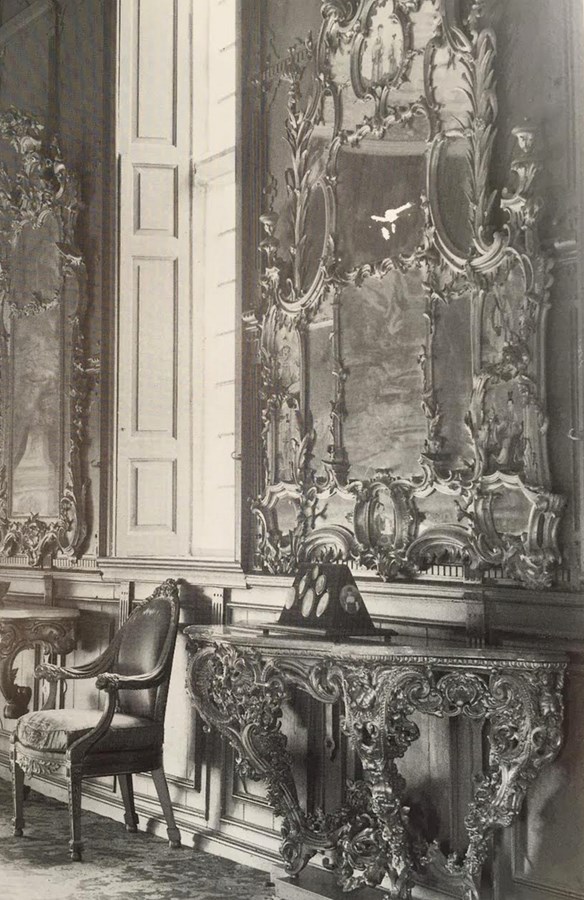
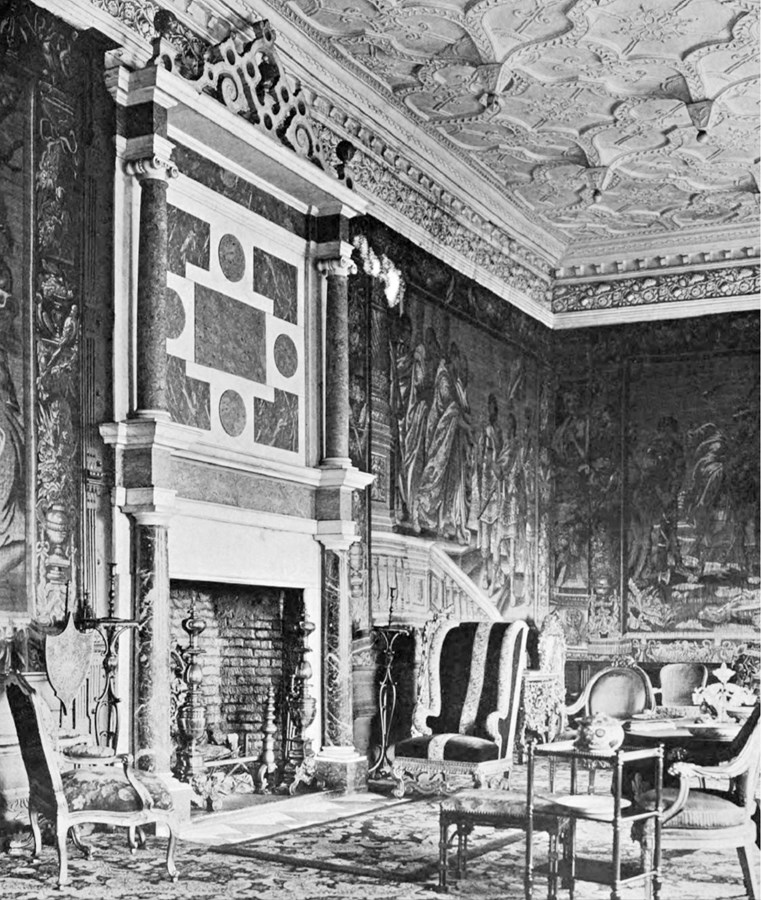


 enquire
enquire
 +44 (0)20 7839 5671
+44 (0)20 7839 5671
 +44 (0)7725 332 665
+44 (0)7725 332 665
